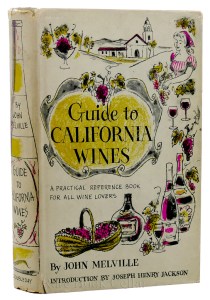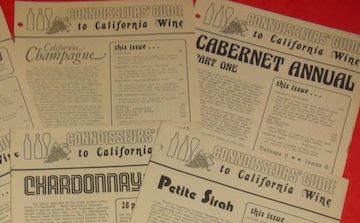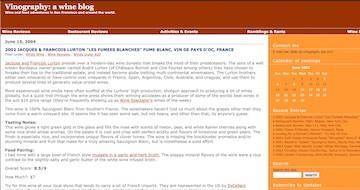Transitions in the Wine Media—And For This Writer Too
 The wine media is a slow-moving ship. Its turns and transitions come slowly. When changes do come to the wine media, they are notions and innovations at first, then the spigot opens and it seems as though it must have always been this way.
The wine media is a slow-moving ship. Its turns and transitions come slowly. When changes do come to the wine media, they are notions and innovations at first, then the spigot opens and it seems as though it must have always been this way.
Up until the 1960s and into the 1970s, the wine media in the United States consisted primarily of books providing the basics on a select number of regions and wines One occasionally would find newspaper articles about “emerging” wine regions in Northern California or about visiting Bordeaux or Burgundy or perhaps a missive about what wine to drink or how to drink wine. But the pickings were sparse.
Beginning in the 1970s more newspaper wine writers came on the scene. The Baby Boomers were coming into their own financially and culturally and were expressing themselves by cultivating their palates. The 1976 Tasting of Paris, at which California wines came out on top in a head-to-head tasting against French wines in France among French palates, also helped convince Americans to try domestic wines. In the 1970s the wine Newsletter came into its own too. The Wine Spectator started as just such a thing. The Connoisseurs Guide to California Wine, the Grapevine, the Robert Finnigan newsletter,—all mailed directly to people’s homes—helped feed the need for more wine education and recommendations. I can’t be sure any of this proliferation of newsletters at the time was driven by new technologies, but that is exactly what spurred later transitions in the wine media.
 An important transition came in the 1980s and 1990s when we saw a real explosion in the American wine media. The Wine Spectator bloomed into a full-blown magazine and icon of the wine industry. It competed against other new magazines such as Wine Enthusiast, Wine News, Quarterly Review of Wine, Wine & Spirits Magazine, The Wine Trader, and a smattering of other wine magazines—of which The Wine Spectator, Wine & Spirits, and Wine Enthusiast survive today. More newsletters came on the scene, including Robert Parker’s Wine Advocate. And it was rare for a daily newspaper to not employ its own wine writer or purchase one of a number of syndicated wine columns.
An important transition came in the 1980s and 1990s when we saw a real explosion in the American wine media. The Wine Spectator bloomed into a full-blown magazine and icon of the wine industry. It competed against other new magazines such as Wine Enthusiast, Wine News, Quarterly Review of Wine, Wine & Spirits Magazine, The Wine Trader, and a smattering of other wine magazines—of which The Wine Spectator, Wine & Spirits, and Wine Enthusiast survive today. More newsletters came on the scene, including Robert Parker’s Wine Advocate. And it was rare for a daily newspaper to not employ its own wine writer or purchase one of a number of syndicated wine columns.
 The 2000s brought another transition with the Internet coming to the fore and wine rushed in. The real development in the 2000s was the emergence of the Wine Blogger. With new publishing platforms that were very inexpensive, now anyone with a set of fingers and maybe a few bucks could publish their thoughts on wine and did they ever. At one point there must have been 1000 different American wine blogs published on the Internet. I was among those who started publishing a blog.
The 2000s brought another transition with the Internet coming to the fore and wine rushed in. The real development in the 2000s was the emergence of the Wine Blogger. With new publishing platforms that were very inexpensive, now anyone with a set of fingers and maybe a few bucks could publish their thoughts on wine and did they ever. At one point there must have been 1000 different American wine blogs published on the Internet. I was among those who started publishing a blog.
The next wine media transition came toward the end of the 2010s when easy podcast technology and distribution channels opened the door for the numerous different wine-related audio broadcasts that were pushed out by, again, the development of relatively inexpensive technology. No matter where we were or where we were driving, we could get an earful of wine info. The 2010s were also when social media platforms began hosting significant wine-related information and with it the rise of the Wine “Influencer”.
I think it is fair to say that despite the many technology-driven transitions in the wine media and the emergence of so many more voices, the general content of what has been said and written has not changed all that much in America since the middle of the 20th century. It still is largely about education, about the wines we drink, and about the culture of wine drinking and winemaking. But because the world changes and because our outlook on our society and culture changes and because new people are always coming to wine, it seems like there is always something new to say…or at least say it in a different way and for different reasons.
My own set of transitions in the wine media world have been small but important for me and even a few readers. It turns out I’ve actually published a blog under five different URLs: ReadWhine.com (I think my mother read this), fermentations.blogger.com, Fermentations.typepad.com, Fermentation. typepad.com (I had to lift the “s” in order to avoid a lawsuit) and now with fermentationwineblog.com.

After 17 years of publishing this wine blog, I’ve decided to make another transition in the very near future. It will mean making another new move. It will be a big deal for me. And it got me thinking about transitions in the wine media.

I sincerely hope you remain active in wine. You provide provocative, carefully thought-out arguments that are vital to the health of the entire wine industry.
Let me guess! You’re going to start your own winery here in the dreary Willamette Valley!?!? If so, jump on in! The water’s fine!
Wishing you much success in whatever direction this new path takes you. All the best!
Tom,
I sure hope you keep writing about wine. I find your articles interesting and informative. You’ve changed my mind more than once,and also pissed me off numerous times! The hallmark of an interesting writer in my estimation. Just promise me the new chapter/platform does not require us to learn Tik Tok dances from you.
Staying in wine, but wouldn’t think about sullying the reputation of Oregon wine by taking a whack at winemaker. Also, RH, no tiktok dances—despite my 7 years of studying tap dancing.
It’s hard to fathom that I have been reading your (often) provocative perspective on wine for at least 16 of those 17 years. Do keep us posted on your moves.
Also wishing you success, Tom. Best wishes to you and hope you “stay in touch.”
Podcast?
My mom was suffering from Type 2 diabetes and Lupus for over 17yrs. She tried many drugs but at last became dependent on saferoom and metformin due to the weakness and constant pains, She found that life was just sinking & there was no way of hope. Then she consulted Chief Dr Lucky for herbal treatments, Which she had been hearing so much about, After some couple of days taking this herbal medicine, Things started to change, The symptoms started to decrease and after 19 days of taking it, She became healthy and fully free from all the symptoms of Type 2 diabetes and Lupus. My mom’s life is totally different now. That’s why I decided to let everybody know about the wonderful healing of Chief Dr Lucky herbal, If you are having any health challenges kindly visit email [email protected] or WhatsApp +2348132777335